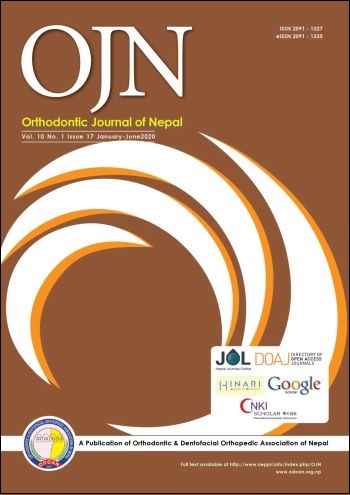Evaluation of Efficacy of Various Implants in Maxillary Arch Distalization - A Finite Element Analysis
DOI:
https://doi.org/10.3126/ojn.v10i1.31005Keywords:
Class II malocclusion, Finite element, Maxillary arch distalization, MiniscrewsAbstract
Introduction: Orthodontic correction of Angle’s class II molar relation has, for long, been one of the challenges in orthodontics, with various researchers attempting to correct the class II molar relationship by diverse methods. One of the techniques that has gained popularity in recent times is maxillary arch distalization by infrazygomatic screws and miniscrews. The objective of the study is to measure and compare the amount of maxillary arch distalization and its effects, on adjacent teeth, by varying the positions of mini-implants by Finite Element Analysis.
Materials & Method: A standard three-dimensional finite element model was constructed to simulate the maxillary teeth, periodontal ligament, and alveolar process. In this study, three models were prepared. Model-1: The (miniscrews) were placed between upper first and second premolar, and between second premolar and first molar bilaterally. Model-2: Infrazygomatic screws was placed between upper first and second molar bilaterally. Model-3: Infrazygomatic screws was placed on the mesio-buccal root of upper first molar bilaterally. The displacement of each tooth was calculated on x, y, and z axes when 200 gm of force was applied on each side.
Result: Maximum amount of maxillary arch distalization was seen when infrazygomatic screws placed between upper first and second molar in model-2. Whereas maximum amount of maxillary arch intrusion and less distalization was observed when miniscrews placed between upper first premolar and second premolar and in between second premolar and upper first molar in model-1. The difference was statistically significant (p=0.005*). There was no bucco-palatal rotation of teeth observed among all three finite element models.
Conclusion: Thus infrazygomatic screws and miniscrews are the effective means of maxillary arch distalization for the correction of Class II malocclusion.
Downloads
314
598
Downloads
Published
How to Cite
Issue
Section
License
Copyright © held by Orthodontic & Dentofacial Orthopedic Association of Nepal
- Copyright on any research article is transferred in full to the Orthodontic & Dentofacial Orthopedic Association of Nepal upon publication in the journal. The copyright transfer includes the right to reproduce and distribute the article in any form of reproduction (printing, electronic media or any other form).
- Articles in the Orthodontic Journal of Nepal are Open Access articles published under the Creative Commons CC BY License (https://creativecommons.org/licenses/by/4.0/)
- This license permits use, distribution and reproduction in any medium, provided the original work is properly cited.




